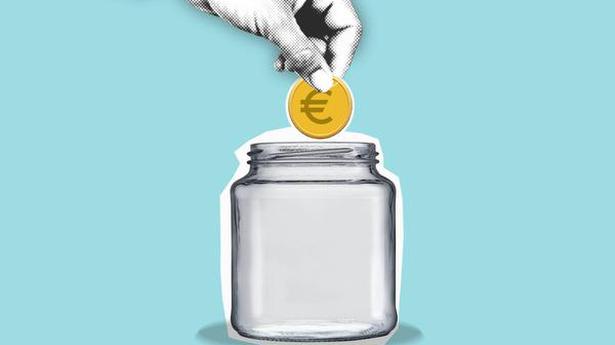The Monetary Policy Committee (MPC) of the Reserve Bank of India on Wednesday increased the policy repo rate by 35 basis points (bps) to 6.25%, and the Standing Deposit Facility stands raised to 6%.
The MPC’s majority view was to withdraw accommodative stance, said RBI Governor Shaktikanta Das.
Inflation is expected to be 6.7% this year, with CPI inflation for the first quarter of 2023-24 projected at 5% and the second quarter at 5.4% on the assumption of a normal monsoon. The focus on inflation control continues and there will be no let-up in our efforts to bring down inflation, first below 6% and then closer to the 4% target, the Governor said.
The central bank’s key committee also marginally lowered the GDP projection to 6.8% for 2022-23, with the third quarter registering 4.4% growth. “India will still be among the fastest-growing major economies in the world and that is something that I think needs to be kept in mind,” Mr. Das said.
The rupee has appreciated by 3.2% in real terms even as several other currencies have dropped. The terminal rate for the U.S. Fed is anyone’s guess, but it cannot be the case that their monetary tightening will continue endlessly. When it stops, the tide will turn, Mr. Das said.
In Q3, economic activity continues to remain firm. Passenger vehicle sales and domestic air passenger traffic growth remained robust and rural demand is recovering. Non-food bank credit rose by ₹10.6 lakh crore from April to November, as compared to ₹1.9 lakh crore last year.
The drag from net external demand was further accentuated in October, as merchandise exports contracted over 12% in October. On the supply side, agriculture remains resilient, Rabi sowing has got off to a strong start with a 6.8% increase in area sown as on December 2 this year.
PMI for Manufacturing and Services also expanded in November. Both manufacturing and Services PMIs in November are among the highest in the world, the Governor added.
Construction activity is picking up after the monsoon as shown by high growth of steel and cement output, he said.
Announcing the hike he said, “As we come to the end of yet another turbulent year, mixed signals are emerging from the geopolitical situation and financial market volatility. The Ukraine invasion by Russia is a black swan event that severely affected energy and food prices around the world.”
Though prices have receded somewhat, inflation remains high. No country is spared the ill effects of these large shocks, but emerging market economies that are dependent on food, commodities, and fuel imports are the worst hit, he said.
“Supply chains are being redrawn on considerations of geopolitics which is now leading to terms like ‘friendshoring’. Our financial system remains robust and stable and corporates are healthier than before the crisis. Bank credit has been growing at double digits for eight months now. India remains a bright spot in the world, yet inflation remains high,” he added.
Going forward, food inflation is likely to moderate with the usual winter softening and a bountiful Rabi crop, but pressure points remain in the prices of cereals, spices and milk, he said.
Consumer price inflation moderated to 6.8% in October as expected but still remains above target. Core inflation is showing stickiness. While headline inflation is expected to moderate over the coming months, it is expected to remain above target till the first quarter of 2023-24, the Governor said.
The MPC was of the view that further calibrated monetary policy is warranted to keep inflation expectations anchored, to rein in core inflation and curtail second round effects (of inflation), he added.
As regards the stance of the monetary policy, the MPC took a holistic view relative to inflation. Adjusted for inflation, liquidity still remains accommodative. The overall monetary and liquidity conditions remain accommodative and hence, the MPC decided to continue the withdrawal of accommodation, the Governor said.
Overall CPI price momentum remains high. Risks from uncertain weather events add dangers to the outlook. The outlook for the U.S. dollar and imported inflation also remains uncertain, he said.
Overall system liquidity remains in surplus. and are likely to improve in the period ahead due to factors, which include moderation in currency in circulation in the post-festive season and higher forex inflows due to the return of foreign portfolio investors, he added.
The growth of services exports, mainly contributed by technology, business services, and travel, continues to be robust. India’s remittances are expected to rise from 89.4 billion dollars in 2021 to over $100 billion this year, he said. The net balances in Services and remittances remain in large surplus, partly offsetting the trade deficit and this gives us comfort on the current account deficit front.
FDI flows are stable and foreign portfolio flows, led by equity, have returned to the Indian market, he added.
“UPI has emerged as the best payment system anywhere in the world. It has been our constant endeavor to try and deepen the reach in India. The UPI currently includes functionality to undertake recurring payments and single-block payments. It is now being enhanced to allow customers to block funds in their accounts for multiple payments of specific nature,” the Governor said.
India’s G20 presidency gives us a great opportunity to influence global outcomes, he added.
On September 30, the RBI hiked the key policy rate (repo) by 50 basis points with an aim to check inflation. It was the third successive hike of 50 bps. Before the September hike, the central bank had raised the repo rate by 50 bps each in June and August, and 40 bps in May.






